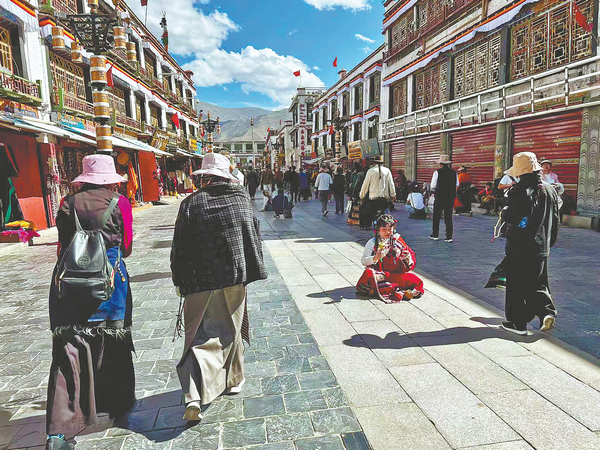

Barkhor Street
Barkhor and its tangled side streets coil like a spiritual circuit around an eponymous square. For over 1,300 years, pilgrims have spun prayer wheels and ceremoniously marched around its circumference.
Its traditional architecture hosts a kaleidoscope of 20 ethnic groups, including Tibetan, Han, Mongolian and Hui. Its shops are packed with virtually every kind of folk art crafted in Xizang, including thangka paintings, yak-butter lamps and traditional incense handcrafted from dozens of ingredients that grow wild on the plateau.
Barkhor is a living labyrinth, where you can lose yourself in what makes Xizang Xizang.
Xizang Museum
The Xizang Museum displays a variety of Buddha and Bodhisattva statues wrought from virtually every medium. It exhibits ancient Tibetan books inscribed with gold, silver and coral. And it showcases technicolor thangka paintings, as well as a mosaic of other ethnic items.
The institution houses the permanent exhibitions, Tibetan History and Culture and The People Closest to the Sun — Tibetan Folk Culture, in addition to temporary displays. It enables visitors to explore the vastness of Xizang before venturing beyond the museum's walls.
Sera Monastery
The monks who clap fiercely in the courtyard of Sera Monastery aren't applauding. They're arguing.
The act of brashly slapping one's right hand on an extended left hand is part of a Buddhist debate format adopted in the 11th century. Monks thwack their palms to challenge an argument, emphasize a question or declare the beginning of a proposition.
The dramatic gesture and loud sound are meant to snap participants out of any distraction, literally smacking their attention into focus. They are accompanied by other dramatic poses that represent different meanings.
Sera is hailed as one of Lhasa's three great Gelug university monasteries, and the dramatic debates are part of its scholarly legacy.
Its name translates as "wild roses", purportedly because these flowers bloomed on Mount Pubuchok when the monastery was built at its foot in 1419.
The 11-hectare compound also hosts the Main Assembly Hall, the Three Sand Mandala Chapels and the Hayagriva Chapel hidden in a secret cave that houses a horse-head deity.
But the main draw for outsiders remains the animated debates that are staged like melodramatic performances.